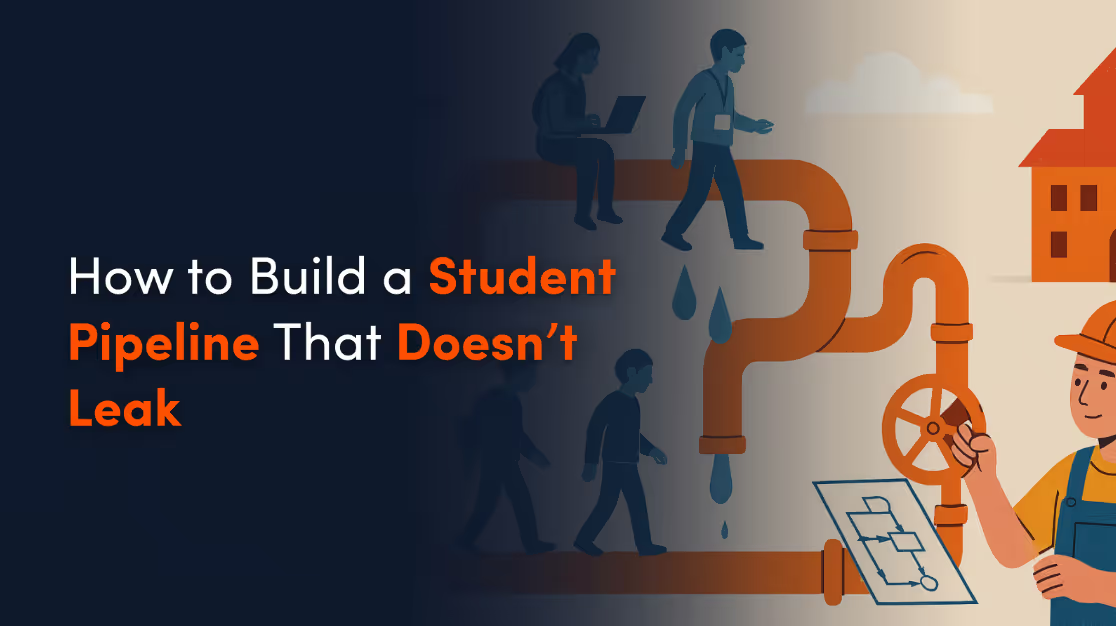About the Blog
In today’s fast-moving world, higher ed recruitment teams can’t afford to let promising prospects slip through the cracks. And yet, without the right systems in place, it happens all the time. The good news? AI is making it easier than ever to design a smart, scalable recruitment pipeline that not only captures the right students but keeps them engaged throughout their decision-making journey.
Whether you’re just getting started with AI or looking to sharpen your current strategy, this guide will walk you through a simple, effective way to leverage AI tools like lead scoring, automated follow-ups, and predictive analytics — without drowning in tech jargon or complicated setups. Let's dive in.
Pipeline Power Moves: Key Insights You Need
- Use AI-powered lead scoring to prioritize the most promising prospects early
- Automate your follow-ups so no lead goes cold, and every student feels seen
- Tap into predictive analytics to spot trends and forecast enrollment behavior
- Personalize at scale with AI-driven insights into student preferences
- Continuously improve your pipeline by feeding AI models updated data
Step 1: Start with Smarter Lead Scoring
Building a strong recruitment pipeline starts with identifying who’s most likely to convert — and that’s where AI-powered lead scoring shines. Instead of guessing or manually sorting through endless inquiry forms, AI analyzes student behaviors (like email engagement, event attendance, and website activity) to assign a “score” to each lead based on their likelihood to enroll.
Think of it like setting up a VIP line: your team gets to focus their time and energy on the prospects who are the best fit and most engaged. Plus, because AI updates these scores automatically, you’ll always have a real-time view of your hottest leads. If you’re using a CRM with AI features, setting up lead scoring is usually a matter of defining the behaviors you want the AI to track — no coding required.
This doesn’t mean ignoring lower-scoring leads; it means you can now tailor your outreach efforts based on where each prospect is in their journey. It’s smarter, faster, and way more student-centered.
Step 2: Set Up Automated Follow-Ups That Feel Human
Following up is where a lot of recruitment teams lose momentum. Life gets busy, lists get long, and before you know it, a great lead has slipped away. That’s why automation is your secret weapon — but not the robotic kind that feels cold or impersonal.
With AI, you can create smart sequences that send timely, personalized emails or text messages based on a student's actions. For example, if a prospect attended a virtual open house but didn’t schedule a meeting afterward, an automated nudge a few days later could make all the difference.
The key here is making the follow-ups feel authentic. Use data points like intended major, previous interactions, or even browsing behavior to personalize your messages. AI can help you do this at scale, meaning every student feels like they’re getting the 1:1 attention they deserve, even when you’re managing thousands of leads.
Step 3: Lean on Predictive Analytics to Stay Ahead
Predictive analytics might sound complicated, but at its core, it’s about using past data to make smarter decisions about the future. And in recruitment, it’s pure gold.
AI tools can crunch historical enrollment data and current engagement trends to predict which leads are most likely to deposit, melt, or need extra nurturing. This means you’re not just reacting to student behavior — you’re anticipating it.
For example, if your model notices that students who download two or more program brochures within a week usually enroll, you can create a special outreach track for leads who hit that milestone. Or, if it flags a dip in engagement from high-potential leads, your team can step in with proactive support.
Predictive analytics gives you a powerful advantage: instead of waiting to see what happens, you’re steering the ship, adjusting your recruitment strategies in real time to maximize yield.
At the end of the day, building an AI-powered recruitment pipeline isn't about replacing the human side of higher ed marketing — it's about enhancing it. When you let AI handle the heavy lifting behind the scenes, you free up your team to focus on what they do best: building real relationships with future students.
Ready to transform your enrollment strategy with AI? Dive deeper into the latest insights and strategies by exploring more content from Enrollify — and keep pushing the boundaries of what's possible in student recruitment.










